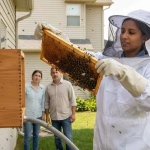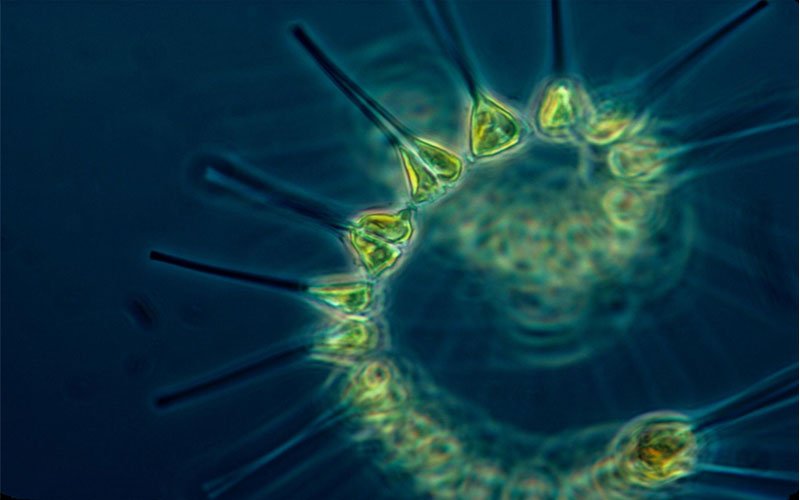Why do whales glide through the deep blue, and what propels the vibrant dance of life beneath the waves? The answer is simpler than you might think: phytoplankton. These microscopic plants are not just the unsung heroes of the ocean. They’re the cornerstone of marine survival.
What eats phytoplankton? This question opens the door to understanding the marine life food chain. It reveals a world where every creature, from the smallest zooplankton to the largest whale, plays a part in a delicate balance of life.
This article sheds light on the unseen but vital role phytoplankton play in supporting sea life. It offers insights into the food chain that sustains the ocean’s vast and varied inhabitants. By exploring what eats phytoplankton, we uncover the fundamental connections that keep the marine ecosystem thriving.
What are Phytoplankton?
Phytoplankton are often described as the grass of the sea. They are tiny plant-like organisms that live in the ocean’s surface waters. They’re too small to see with the naked eye, but together, they form masses visible from space, colouring the ocean in vast swathes of green and blue.
These microscopic plants perform a critical function: photosynthesis. By converting sunlight, carbon dioxide, and nutrients into organic matter, they produce over half of the world’s oxygen, rivalling trees and plants on land.
The role of phytoplankton goes beyond oxygen production. They are the foundation of the marine life food chain. Every marine creature, from the smallest zooplankton to the largest whales, depends on them either directly or indirectly for food.
This makes them an essential element of the food chain for marine life, supporting the vast biodiversity of the ocean. Their abundance and health directly influence fish populations, sea creatures’ distribution, and the overall health of marine ecosystems. You can find phytoplankton for sale here.
What Eats Phytoplankton?
At the heart of the marine food chain, just above phytoplankton, are the primary consumers. These are the immediate grazers of the ocean. Primary consumers include a diverse group of organisms that feed on phytoplankton and play a crucial role in transferring energy up the food chain.
Zooplankton are among the most direct consumers of phytoplankton. These tiny animals range from microscopic copepods to larger jellyfish-like creatures.
By feeding on phytoplankton, zooplankton act as a crucial link. They transfer the energy phytoplankton gather from the sun to the rest of the marine ecosystem.
Small Fishes also play a significant part in this energy transfer. They don’t usually eat phytoplankton directly but consume large amounts of zooplankton. This process illustrates the interconnectedness of sea life, where the survival of one group is tightly linked to the existence of another.
Small fish species, such as anchovies and sardines, are key players in this respect. They serve as a bridge between the lower levels of the food chain and the larger predators.
Filter Feeders represent another group of primary consumers. These sea creatures include certain species of whales, oysters, and clams. They consume phytoplankton by filtering water through their systems.
For example, the blue whale, the largest animal on the planet, relies heavily on tiny krill, a type of zooplankton, for its diet. Similarly, oysters filter water to capture phytoplankton. They play a dual role in feeding and purifying the water.
Secondary Consumers and Beyond
In the ocean’s vast cafeteria, larger predatory fish act as secondary consumers. They dine on the smaller fish that feast on phytoplankton and zooplankton.
Species like tuna, sharks, and salmon are crucial players in this part of the food chain. They showcase the ripple effect phytoplankton have across the marine ecosystem. These predators ensure the health and balance of the marine environment by controlling the population of smaller fish, thereby preventing the overgrazing of phytoplankton populations.
Marine mammals, including seals and larger whales, represent the higher tiers of the marine food chain. Seals often prey on fish and squid. This links them back to the microscopic plants at the food chain’s base.
Meanwhile, baleen whales, such as the humpback and blue whale, consume krill and small fish in massive amounts. They play a vital role in the ocean’s energy transfer system.
These majestic creatures depend on the health of phytoplankton populations for their survival. This highlights the interconnectedness of marine life.
The energy transfer through the food chain, starting from phytoplankton, underscores the ecological balance within the ocean. As energy moves from the base to the apex predators, it ensures the diversity and stability of marine ecosystems. This demonstrates how every creature, big or small, relies on the foundational role of phytoplankton.
Human Impact on Phytoplankton
Humans have a profound impact on the ocean’s smallest inhabitants, phytoplankton. Pollution, particularly from agricultural runoff, introduces excessive nutrients into the ocean. This leads to harmful algal blooms that can deplete oxygen and block sunlight, making it difficult for phytoplankton to survive.
Climate change also plays a significant role in altering ocean temperatures and currents. This can disrupt the habitats and growth cycles of phytoplankton.
Overfishing is another human activity with indirect effects on phytoplankton. By reducing the populations of certain fish species, we can unintentionally alter the delicate balance of the marine food chain and affect phytoplankton populations indirectly.
These human activities not only threaten phytoplankton but also have a cascading effect on the entire marine food chain. Changes in phytoplankton abundance can lead to shifts in the populations of their predators and the predators’ predators. This demonstrates the far-reaching implications of human impact on the ocean’s ecosystems.
Protecting phytoplankton means preserving the intricate web of life that sustains the diversity and abundance of marine life.
The Keystone of Ocean Life
Unveiling the mystery of what eats phytoplankton has taken us through the vibrant corridors of marine life. We’ve illustrated the foundational role these tiny organisms play in the oceanic food web. From nurturing the smallest of zooplankton to sustaining majestic marine mammals, phytoplankton are the unsung heroes of the sea.
This exploration not only highlights their importance but also underscores our responsibility towards preserving these crucial elements of marine ecosystems. For more fascinating insights into the creatures that inhabit our oceans, continue exploring our Animal section.















